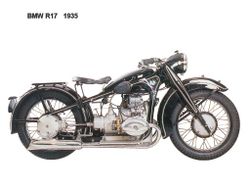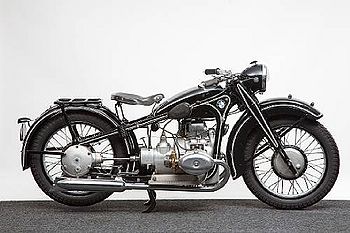BMW R17: history, specs, pictures
 |
|
| BMW R17 | |
| Manufacturer | |
|---|---|
| Production | 1935 - 1937 |
| Class | Classic |
| Predecessor | BMW R16 |
| Engine | 736cc air-cooled, two cylinder boxer, four-stroke, OHV, 2 valves per cylinder |
| Bore / Stroke | 83.0mm x 68.0mm |
| Compression ratio | 6.5:1 |
| Top Speed | 87 mph (140 km/h) |
| Horsepower | 32.99 HP (24.6 KW) @ 5000RPM |
| Fuel System | carburetor. amal 26mm |
| Ignition | battery |
| Transmission | Gear box: 4-speed Final Drive: shaft drive (cardan) |
| Suspension | Front: cartridge Rear: rigid |
| Brakes | Front: expanding brake (drum brake) Rear: expanding brake (drum brake) |
| Front Tire | 3.5-19 |
| Rear Tire | 3.5-19 |
| Wheelbase | 54.33 inches (1380 mm) |
| Length | 82.68 inches (2100 mm) |
| Width | 35.04 inches (890 mm) |
| Height | 37.01 inches (940 mm) |
| Weight | 165.0 kg (wet) |
| Fuel Capacity | 3.7 Gallon (14.00 Liters) |
| Related | BMW R12 |
| Manuals | Service Manual |
The BMW R17 was a two cylinder boxer, four-stroke standard produced by BMW between 1935 and 1937. It could reach a top speed of 87 mph (140 km/h). Claimed horsepower was 32.32 HP (24.1 KW) @ 4500 RPM.
History[edit | edit source]
Only 450 BMW R17's were produced over a two year period. There was a supersports model R17 with 33 hp, that was only surpassed by the R68 in 1972! The R17's like many other BMWs were often found with Steib sidecars, styled similar to Zeppelin airships. There are very few R17s left worldwide.
Having broken fresh ground with the launch of the pressed-steel framed R11 in 1930, BMW followed that up with the introduction of an hydraulically-damped telescopic front fork on the BM R12 and BMW R17 models, which were also notable as the first BMWs to have a four-speed gearbox. First seen at the Berlin Motor Show in February 1935, the newcomers were otherwise virtually unchanged from their R11 and R16 predecessors apart from a strengthened crankshaft. The sporting, twin-carburetor, overhead-valve R17 produced 33bhp at 5,000rpm and would be BMW's most powerful production roadster until the introduction of the BMW R68 in 1952. It was priced at 2,040 Reichsmarks, making the R17 the most expensive German motorcycle of its day. Only 436 were produced between 1935 and 1937 and today this rare and exclusive model is one of the most sought after of pre-war BMW motorcycles.
Engine[edit | edit source]
The engine was a air cooled two cylinder boxer, four-stroke. A 83.0mm bore x 68.0mm stroke result in a displacement of just 736.0 cubic centimeters. Fuel was supplied via a overhead valves (ohv).
Drive[edit | edit source]
The bike has a 4-speed transmission. Power was moderated via the dry-multiplate-cable operated.
Chassis[edit | edit source]
It came with a 3.5-19 front tire and a 3.5-19 rear tire. Stopping was achieved via expanding brake (drum brake) in the front and a expanding brake (drum brake) in the rear. The front suspension was a cartridge while the rear was equipped with a rigid. The R17 was fitted with a 3.7 Gallon (14.00 Liters) fuel tank. The wheelbase was 54.33 inches (1380 mm) long.
1935 - 1937 BMW R 17[edit | edit source]
The 1935 BMW R 17 has, at its heart, an air-cooled, four-stroke, 735cc, flat twin cylinder powerhouse mated to a four-speed manual transmission that can produce a claimed 33 horsepower at 5000 rpm. It boasts a dual exhaust system, laced wheels, a rear luggage rack, wide handlebars, a suspension package composed of a telescopic front fork and a hard-tail rear unit with a sprung saddle, a drum braking system, a large, round headlamp and a dry, double plate clutch.
| |||||||||||||||||




